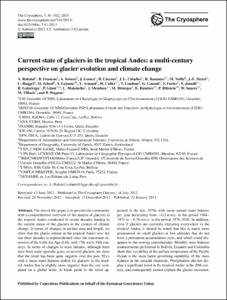Mostrar el registro sencillo del ítem
Current state of glaciers in the tropical Andes: a multi-century perspective on glacier evolution and climate change
| dc.contributor.author | Rabatel, Antoine | |
| dc.contributor.author | Francou, Bernard | |
| dc.contributor.author | Soruco, Alvaro | |
| dc.contributor.author | Gómez López, Jesús | |
| dc.contributor.author | Cáceres, B. | |
| dc.contributor.author | Ceballos, J. L. | |
| dc.contributor.author | Basantes, R. | |
| dc.contributor.author | Vuille, Mathias | |
| dc.contributor.author | Sicart, Jean Emmanuel | |
| dc.contributor.author | Huggel, Christian | |
| dc.contributor.author | Scheel, M. | |
| dc.contributor.author | Lejeune, Y. | |
| dc.contributor.author | Arnaud, Yves | |
| dc.contributor.author | Collet, M. | |
| dc.contributor.author | Condom, Thomas | |
| dc.contributor.author | Consoli, G. | |
| dc.contributor.author | Favier, V. | |
| dc.contributor.author | Jomelli, V. | |
| dc.contributor.author | Galagarra, R. | |
| dc.contributor.author | Ginot, P. | |
| dc.contributor.author | Maisincho, L | |
| dc.contributor.author | Mendoza, J. | |
| dc.contributor.author | Menegoz, M. | |
| dc.contributor.author | Ramírez, E. | |
| dc.contributor.author | Ribstein, P. | |
| dc.contributor.author | Suarez, Wilson | |
| dc.contributor.author | Villacis, M. | |
| dc.contributor.author | Wagnon, Patrick | |
| dc.coverage.spatial | Cordillera Blanca | |
| dc.date.accessioned | 2019-01-11T20:25:14Z | |
| dc.date.available | 2019-01-11T20:25:14Z | |
| dc.date.issued | 2013 | |
| dc.identifier.citation | Rabatel, A., Francou, B., Soruco, A. et. al. (2013) Current state of glaciers in the tropical Andes: a multi-century perspective on glacier evolution and climate change. The Cryosphere, 81, 102-118. doi: https://doi.org/10.5194/tc-7-81-2013 | es_PE |
| dc.identifier.issn | ISSN: 1994-0416, ESSN: 1994-0424 | es_PE |
| dc.identifier.uri | https://hdl.handle.net/20.500.12543/3233 | |
| dc.description | Original abstract: The aim of this paper is to provide the community with a comprehensive overview of the studies of glaciers in the tropical Andes conducted in recent decades leading to the current status of the glaciers in the context of climate change. In terms of changes in surface area and length, we show that the glacier retreat in the tropical Andes over the last three decades is unprecedented since the maximum extension of the Little Ice Age (LIA, mid-17th–early 18th century). In terms of changes in mass balance, although there have been some sporadic gains on several glaciers, we show that the trend has been quite negative over the past 50 yr, with a mean mass balance deficit for glaciers in the tropical Andes that is slightly more negative than the one computed on a global scale. A break point in the trend appeared in the late 1970s with mean annual mass balance per year decreasing from -0.2 m w.e. in the period 1964–1975 to -0.76 m w.e. in the period 1976–2010. In addition, even if glaciers are currently retreating everywhere in the tropical Andes, it should be noted that this is much more pronounced on small glaciers at low altitudes that do not have a permanent accumulation zone, and which could disappear in the coming years/decades. Monthly mass balance measurements performed in Bolivia, Ecuador and Colombia show that variability of the surface temperature of the Pacific Ocean is the main factor governing variability of the mass balance at the decadal timescale. Precipitation did not display a significant trend in the tropical Andes in the 20th century, and consequently cannot explain the glacier recession. On the other hand, temperature increased at a significant rate of 0.10 °C decade-1 in the last 70 yr. The higher frequency of El Niño events and changes in its spatial and temporal occurrence since the late 1970s together with a warming troposphere over the tropical Andes may thus explain much of the recent dramatic shrinkage of glaciers in this part of the world. | es_PE |
| dc.description | Artículo en acceso abierto | es_PE |
| dc.description.abstract | Proporciona un panorama completo de los estudios de glaciares en los Andes tropicales realizados en las últimas décadas que conduzcan al estado de los glaciares en el contexto del cambio climático. En cuanto a los cambios en la superficie y la longitud, muestra que el retroceso del glaciar en los Andes tropicales en las últimas tres décadas no tiene precedentes desde la extensión máxima de la Pequeña Edad de Hielo (LIA, mediados del siglo XVII a principios del siglo XVIII). Respecto a los cambios en el balance de masas, muestra que la tendencia ha sido negativa en los últimos 50 años. | es_PE |
| dc.format | application/pdf | es_PE |
| dc.language.iso | eng | es_PE |
| dc.publisher | EGU | es_PE |
| dc.relation.ispartofseries | The Cryosphere, 2013, Volumen 7, pp 103-118 | es_PE |
| dc.relation.uri | https://www.the-cryosphere.net/7/81/2013/ | |
| dc.rights | info:eu-repo/semantics/openAccess | es_PE |
| dc.rights | Attribution-NonCommercial-NoDerivatives 4.0 International | * |
| dc.rights.uri | https://creativecommons.org/licenses/by-nc-nd/4.0/ | * |
| dc.source | Autoridad Nacional del Agua | es_PE |
| dc.source | Repositorio institucional - ANA | es_PE |
| dc.subject | Cambio climático | es_PE |
| dc.subject | Conservación de glaciares | es_PE |
| dc.subject | Monitoreo de lagunas y glaciares | es_PE |
| dc.title | Current state of glaciers in the tropical Andes: a multi-century perspective on glacier evolution and climate change | es_PE |
| dc.type | info:eu-repo/semantics/article | es_PE |
| dc.identifier.doi | https://doi.org/10.5194/tc-7-81-2013 | es_PE |








